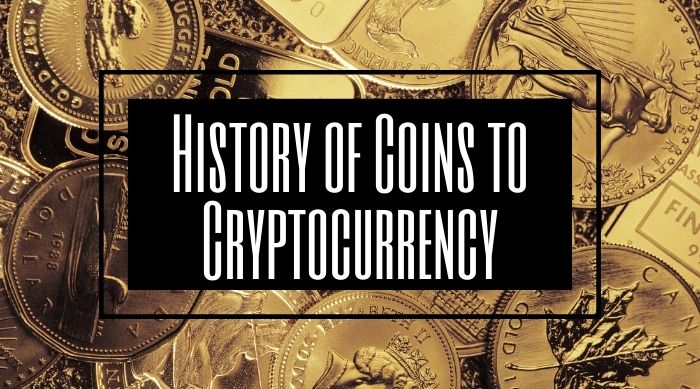The notion of the coin as a unit of currency has a long and varied history, from proto-coins (the earliest trading done with shells and other naturally occurring objects), all the way to crypto. For the purposes of our discussion here, “coins” refer to objects or tokens that are made specifically for the purpose of buying, selling, and trading.

The use of coins as currency transcends nations. In Japan, the gold koban is an early example, circa 1600, but coinage (especially gold coins) goes back much farther in history. An African kingdom in northern Ethiopia minted gold coins during the reign of Aksumite kings between the 2nd and 9th centuries. The use of coins there started in the 3rd century.
Another of the earliest examples is the Lydia coin–also gold–minted some 2500 years ago. One of the oldest coins still in use is the Greek drachma, and in America, it was roughly 16 years after the revolution before the fledgling nation would begin minting its own coinage.
A Brief History Of American Coins
According to the United States Mint, the earliest coins officially minted by the United States government post-revolution were “half-dimes”, minted in 1792 (see below). These were made of mostly silver and unlike the later five-cent coin, there was no trace of nickel in them. The first American coin to make it into circulation was a precursor to the one-cent coin we know today.
1787: Year Of The Penny
Naturally, the one-cent coin wasn’t immediately known as the “penny”. In 1787, Congress approved the creation of a supply of one-cent coins then called Fugio cents.
But thanks to the passage of the Constitution of the United States, a whole new discussion about the need for standardized national legal tender would begin, leading up to an important piece of legislation. But prior to this, there was plenty of other coinage circulating in the 13 colonies.
In the same way that colonists arrived in America from a variety of different countries, there were a variety of coins from other nations in circulation. These included German, Spanish, and British coins, plus the money created by individual colonies.
As you can imagine, this lack of standardization was not without its problems including the notion that a coin would be worth more or less depending on where you tried to spend it.
Coinage Act of 1792
The Coinage Act of 1792 was responsible for selecting the units of measure for coins (including the establishment of the value of one dollar being 100 pennies) as well as the construction and composition of them. Copper coins, silver coins, and gold coins were authorized–this was long before the gold standard for the American dollar was eliminated.
In 1792, during construction of the United States Mint, some 1,500 silver half dimes were minted but not placed into circulation. The first official U.S. coins offered by the U.S. Mint were made available in 1793 to the tune of over 11,000 copper one-cent coins.
Believe it or not, these early pennies were about the size of a modern quarter and came in a half-cent version that was later retired. Some sources say the reason for this had to do with controlling production costs and trying to make the most of a commodity (copper) that was going up in price.
In 1857, the size of the one-cent coin would be reduced to further cut costs. That same year, Congress would pass a law forbidding the use of overseas currency as legal tender.
Good-Bye Gold Standard
U.S. coins would change for good in 1933 when the United States ended the use of the gold standard to back its currency.
On June 5, 1933, Congress enacted a joint resolution that essentially ended the ability to ask for gold in exchange for legal paper money or coins minted in the U.S. Thanks to the Great Depression, some began hoarding gold and the gold standard basically became unsustainable. Today’s currency is backed by faith and public enthusiasm in addition to other measures designed to protect the U.S. economic system like deposit insurance, Fed policies, and other federal regulation.
A few decades later, changes to U.S. coin composition would further alter how U.S. currency as physical objects would be valued.
American Coinage: Some Coins Are Better Than Others
Since 1964, U.S. coinage has experienced a variety of changes in both the aesthetics and the composition of the money. Some were experimental, some lasted the test of time all the way up to the 21st century. Some still remember the advent of the U.S. dollar coin–and some still complain about how similar it was to its’ more humble counterpart, the quarter.
After 1933 and before 1964, some types of American money still had inherent value, rather than being valued according to the good faith and confidence of the American public. The reason? Silver.
Today’s coinage doesn’t contain precious metals like gold or silver but lucky collectors may find early American coins that do contain precious metals; the “mercury dime” is a good example.
In fact, there are a number of U.S. coins that contain silver. They include:
- Roosevelt dimes
- Mercury dimes
- Washington Quarters
- Walking Liberty Franklin half dollars
- Kennedy Half-Dollars
The coins in the list above with dates on or before 1964 are said to be 90% silver, and the reason these coins are prized is chiefly to do with that composition.
Coins Versus Tokens
It is illegal in America to make replicas of legal tender with the intent to spend it like the real thing. Yet, American consumer culture is full of examples of how “coins” are used like real money even when they are not. The old 20th-century notion of the video game arcade is a great example–many arcades featured coin-operated games that did not accept quarters, but game tokens instead.
The way arcade owners got away with this had much to do with the fact that you were only meant to spend these tokens in the arcade to play games. They had no value outside the gaming environment, or at least hypothetically. The coins did not look like the real thing, were generally configured to operate only with the proprietary coin-op devices that accepted them, and were “purchased” with real-world money.
Sound familiar?
Tokens Versus Crypto Tokens
Crypto tokens share, at least in spirit, some similarities with video game tokens. Both are only worth as much as someone is willing to pay for them, both can be used to play games but may also be sold or traded. And neither one is considered legal tender. You can’t purchase a house with crypto in the same way you can’t do the same thing with video game tokens. “Legal tender” is a term that has teeth in the legal sense.
But how did crypto tokens and cryptocurrency rise to the prominence video game tokens never could?
Crypto Coins
2008 is the year Satoshi Nakamoto, the person or collective, writes a whitepaper that would profoundly change parts of global commerce forever. Bitcoin: A Peer-to-Peer Electronic Cash System was the opening salvo in a “war” to decentralize finance, make transactions “trustless”, and enable people to earn large fortunes buying, selling, and trading cryptocurrency.
We might not ever know what was purchased with the very first U.S. pennies or dimes. But we do know what the first Bitcoin purchase was–someone used the cryptocurrency to buy two pizzas in 2010. How much was one Bitcoin worth in those days?
To calculate that, you’ll need the actual amount paid for those pizzas. Some are shocked to learn that it took TEN THOUSAND BTC to make that payment, then the equivalent of $20.
The rest is, as they say, history.
Today, cryptocurrency is not legal tender in the USA. But those who accept it as payment or compensation for goods, services, or access are able to convert it to legal tender, albeit with potential fees, and/or risk of loss if the conversion rate isn’t in the trader’s favor.
Crypto is likely to experience a similar evolution of sorts as the U.S. dollar and all coins associated with American currency. The real question is whether that evolution will include regulation, devaluation, or being declared illegal altogether. In light of the story of American legal tender, it’s possible we will have to wait many years to see what direction Bitcoin and other currencies like it are able to take.
Joe Wallace has covered real estate and financial topics, including crypto and NFTs since 1995. His work has appeared on Veteran.com, The Pentagon Channel, ABC and many print and online publications. Joe is a 13-year veteran of the United States Air Force and a former reporter for Air Force Television News.


